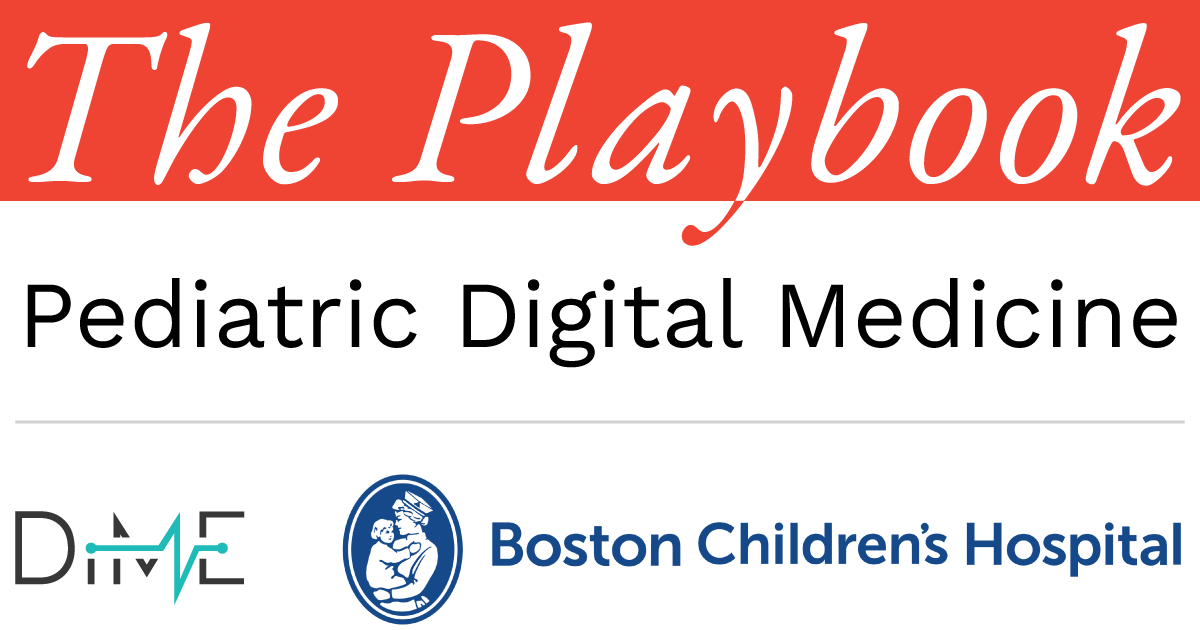
Chapter 2 – Section 4
Pediatric data and ethics

Data and ethics cannot be uncoupled in pediatrics. The unique blend of stakeholders in children’s care systems, their complex developmental stages, and the very nature of their technology use requires intentional strategies to ensure that their rights and decisions are appropriately considered.
This section will give you insights, recommendations and other considerations to help guide you through these complexities.
Privacy, data security, and regulatory challenges
When developing pediatric DHTs, data privacy and ethical considerations are paramount. Children’s health data is subject to stricter privacy regulations, such as Health Insurance Portability and Accountability Act (HIPAA) and Children’s Online Privacy Protection Act (COPPA), and DHT developers must carefully balance privacy, security, and access, especially as pediatric patients grow older and seek more autonomy.
Key Challenges:
- Navigating complex regulations around children’s health data.
- Ensuring secure data handling and privacy, particularly as children transition to more independent management of their health.
- Designing ethical frameworks for consent, data usage, and transparency.
Building trust through data security and privacy is essential to the success of pediatric DHTs, and addressing ethical considerations at the design stage is crucial.
Health Insurance Portability and Accountability Act (HIPAA):
An Act of Congress that outlines the lawful use and disclosure of protected health information (PHI) in the United States. HIPAA compliance is regulated by the Department of Health and Human Services (HHS) and enforced by the Office for Civil Rights (OCR).
Children’s Online Privacy Protection Act (COPPA):
A law that protects the online information of children under 13 years old. It applies to operators of websites and online services that target children, and requires them to obtain parental consent before collecting personal information from children. COPPA was designed to safeguard young people from potential abuse and privacy violations because children cannot legally consent to the use of their data.

Key insights
State-by-state variability in adolescent privacy laws
This article breaks down how different U.S. states handle teens’ privacy rights in healthcare, especially when it comes to accessing confidential services without needing parental permission. The piece dives into how these rules vary widely, which can create real barriers for teens needing discreet care, and discusses what these differences mean for healthcare providers and policy changes aimed at better supporting adolescent privacy.
Navigating data privacy and compliance
Data privacy laws, such as COPPA and HIPAA, provide frameworks for handling pediatric health data. Ensuring compliance with these regulations is vital to avoid legal risks and to maintain the trust of caregivers and clinicians. Pediatric data needs special protections due to its sensitivity and the long-term consequences of potential breaches.
Implement clear and transparent protocols for obtaining and managing parental consent for data collection, access, and use in digital health tools. Consider how these protocols adapt and change as children age and gain independence and autonomy.
Include compliance audits as a standard practice during both the development and implementation phases to identify and address vulnerabilities early.
Engage with caregivers about their rights regarding their child’s data, including how they can manage permissions or revoke consent, or where their rights cease and the child’s take precedence.
Balancing parental involvement and child autonomy
As children age, their level of autonomy in managing their own health increases. DHTs must accommodate the gradual shift from parental oversight to child autonomy, providing both privacy and transparency in data management.
Challenges:
- Parents may want control over their child’s health data, but adolescents often seek privacy regarding certain health issues (e.g., sexual and mental health).
- Navigating the transition from full parental control to patient-driven autonomy in a way that respects both parties.

- Tiered access systems: Design systems that provide different levels of access based on the patient’s age and maturity, giving caregivers oversight when needed but offering adolescents control over their data and health management.
- Dynamic consent: Enable dynamic consent models that evolve over time, allowing patients to gradually take ownership of their health data while still ensuring caregivers have visibility into critical areas of care.
Ensuring data security
To build trust and ensure effective care, DHT developers must safeguard personal health information while enabling secure, equitable data sharing. A robust approach to privacy and security should also account for interoperability, ensuring data flows appropriately within a connected healthcare ecosystem.
Challenges:
- Growing threats of cyberattacks and the need for advanced security infrastructure.
- Balancing stringent data protection measures with the usability needs of patients, caregivers, and clinicians.
- Ensuring interoperability supports secure, equitable access to data across diverse care settings.

- Data encryption: Encrypt all data in transit and at rest to protect sensitive information from unauthorized access.
- Secure authentication: Use multi-factor authentication (MFA) and role-based access control (RBAC) to restrict access to authorized users only.
- Data minimization: Collect and store only the necessary data for patient care, reducing the risk of breaches by limiting exposure.
- Equitable interoperability: Implement systems that allow data to be shared securely and appropriately across platforms. Solutions like SHIFT can help create inclusive data-sharing frameworks.
Long-term data management and security
Ethical considerations must guide the development of pediatric DHTs. Developers need to be transparent about how data is collected, used, and shared, ensuring that both patients and caregivers understand and consent to data practices.
Challenges:
- Managing the growing volume of data over the years.
- Ensuring data remains secure yet accessible during transitions from pediatric to adult care.
- Mitigating risks associated with incomplete, inaccurate, or contextually invalid data collection and analysis.

- Lifecycle data management: Prioritize security while allowing for the gradual transition of access to the patient. Account for data portability as children age out of pediatric care.
- Quality frameworks: Implement a quality framework that prioritizes data accuracy, completeness, and contextual validity throughout the lifecycle of the DHT. This framework should guide data collection, storage, and analysis.
- HL7 FHIR standards: Follow FHIR standards to ensure that data flows seamlessly across systems, enabling more coordinated, timely, and personalized care for children.
Operating with ethics and transparency
Ethical considerations must guide the development of pediatric DHTs. Developers need to be transparent about how data is collected, used, and shared, ensuring that both patients and caregivers understand and consent to data practices.
Challenges:
- Communicating data practices in a way that is accessible to both children and their caregivers.
- Ensuring that data usage aligns with ethical principles, particularly around consent, transparency, and patient rights.

- Clear communication: Provide simple, child-friendly explanations of how data is being used, and create caregiver resources that offer detailed transparency on data policies.
- Ethical data practices: Ensure that data is used solely for the intended purpose of improving patient care, and avoid practices that may compromise patient trust or privacy.
- Data-sharing agreements: Develop easy-to-understand agreements that outline how information is shared with schools, clinicians, or researchers, ensuring that patients and caregivers remain fully informed.
Building trust through privacy and security
Building pediatric DHTs that prioritize data privacy, security, and ethical transparency is crucial to gaining the trust of patients, caregivers, and healthcare providers. Trust is foundational to the adoption and long-term success of any digital health tool.
Key Takeaways:
Start with privacy by design:
Incorporate privacy, consent, and security into the design process from day one to ensure compliance with legal frameworks and user trust.
Plan for growth:
Focus on ethics:

Key takeaways
Continuous improvement and maintenance is an ethical imperative
Continuous improvement and maintenance in pediatric DHT is not just a best practice; it’s an ethical imperative. By committing to ongoing evaluation and enhancement, you ensure that these tools remain effective, safe, and responsive to the evolving needs of children and their families. This proactive approach fosters trust and accountability, ultimately safeguarding the well-being of our most vulnerable patients.
Conclusion

Key takeaways
Key takeaways and calls to action
Children and their care systems are fundamentally different from adults, influencing how DHTs can and should be developed. Factors such as physical and cognitive development, relationships with caregivers and community systems, access to technologies, and specific health needs must inform the design and implementation of pediatric DHTs.
To truly improve outcomes and transform care, it is essential to adopt a human-centered development approach that places pediatric patients, caregivers, and clinicians at the forefront of the product development process.
-
 Embed clinical SMEs into your product teams to guide evidence-based decisions and ensure the technology addresses real-world clinical needs.
Embed clinical SMEs into your product teams to guide evidence-based decisions and ensure the technology addresses real-world clinical needs. -
 Centralize the pediatric care system by engaging all stakeholders—children, caregivers, and clinicians—from the outset and establish ongoing feedback mechanisms to refine the product based on their insights and experiences.
Centralize the pediatric care system by engaging all stakeholders—children, caregivers, and clinicians—from the outset and establish ongoing feedback mechanisms to refine the product based on their insights and experiences. -
 Prioritize data privacy, quality, and ethical considerations by implementing robust security measures and ensuring that children’s rights are upheld throughout the technology’s lifecycle.
Prioritize data privacy, quality, and ethical considerations by implementing robust security measures and ensuring that children’s rights are upheld throughout the technology’s lifecycle. -
 Design DHTs that are flexible and can adapt to various healthcare settings, caregiving and consent dynamics, and individual needs of the user.
Design DHTs that are flexible and can adapt to various healthcare settings, caregiving and consent dynamics, and individual needs of the user. -
 Continuous evaluation: Implement a framework for ongoing evaluation and improvement based on user feedback and emerging best practices, ensuring that the technology evolves in response to changing needs.
Continuous evaluation: Implement a framework for ongoing evaluation and improvement based on user feedback and emerging best practices, ensuring that the technology evolves in response to changing needs.




